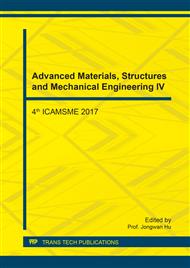[1]
I. Soltani, S. Hraiech, K. Horchani-Neifer, H. Elhouichet, B. Gelloz, M. Ferid. Growth of silver nanoparticles stimulates spectroscopic properties of Er3+ doped phosphate glasses: Heat treatment effect. J. Alloys Comp. 686 (2016) 556-563.
DOI: 10.1016/j.jallcom.2016.06.027
Google Scholar
[2]
K. Hattori, T. Kitagawa, Y. Ohmori, Gain Switching of an Erbium-doped Silica-Based Planar Waveguide. J. Appl. Phys. 79 (1996) 1238.
DOI: 10.1063/1.361017
Google Scholar
[3]
Doremus. Glass Science, John Wiley & Sons, New York, (1994).
Google Scholar
[4]
M. J. Weber, Science and Technology of Laser Glass. J. Non-Cryst. Solids, 123 (1990) 208-222.
Google Scholar
[5]
R. K. Brow, Review: The Structure of Simple Phosphate Glasses. J. Non-Cryst. Solids, 263 & 264 (2000) 1-28.
DOI: 10.1016/s0022-3093(99)00620-1
Google Scholar
[6]
J. T. Hunt, D. R. Speck, Present and Future Performance of the Nova Laser System. Opt. Eng. 28 (1989) 461.
DOI: 10.1117/12.7976974
Google Scholar
[7]
J. H. Campbell, T. I. Suratwala, C. B. Thorness, J. S. Hayden, A. J. Thorne, Continuous Melting of Phosphate Laser Glasses. J. Non-Cryst. Solids, 263 & 264 (2000) 342-357.
DOI: 10.1016/s0022-3093(99)00675-4
Google Scholar
[8]
K. El-Egili, H. Doweidar, Y. M. Moustafa, I. Abbas, Structure and some Physical Properties of PbO-P2O5 Glasses. Phusica 339 (2003) 237.
DOI: 10.1016/j.physb.2003.07.005
Google Scholar
[9]
H. Desirena, E. De la Rosa, L. A. Diaz-Torres, G. A. Kumar, Concentration Effect of Er3+ and Yb3+/Er3+ Co-Doped Phosphate Glasses. Opt. Mater. 28 (2006) 560-569.
DOI: 10.1016/j.optmat.2005.04.002
Google Scholar
[10]
A. A. Higazy, Electrical Conductivity and Dielectric Constant of Magnesium Phosphate Glasses. Matter. Lett. 22 (1995) 289.
DOI: 10.1016/0167-577x(94)00254-1
Google Scholar
[11]
F. F. Sene, J. R. Martinelli, L. Gomes, Optical and structural characterization of rare earth doped niobium phosphate glasses, J. Non-Cryst. Solids, 48 (2004) 63-71.
DOI: 10.1016/j.jnoncrysol.2004.08.127
Google Scholar
[12]
K. Subrahmanyam, M. Salagram. Optical band gap studies on (55-x)Na2O-xPbO-45P2O5 (SLP) glass system. Opt. Mater. 15 (2000) 181-186.
DOI: 10.1016/s0925-3467(00)00033-1
Google Scholar
[13]
A. A. Kader, R. El-Mallawany, M. M. Elkholy, Network Structure of Tellurite Phosphate Glasses: Optical and Infrared Spectra. J. Apply. Phys. 73(1) (1993) 71-74.
DOI: 10.1063/1.354064
Google Scholar
[14]
G. Vijaya Prakash, D. Narayana Rao, A. K. Bhatnagar. Linear Optical Properties of Niobium Based Tellurite glasses. Sol. St. Comm. 119 (2001) 39-44.
DOI: 10.1016/s0038-1098(01)00195-8
Google Scholar


